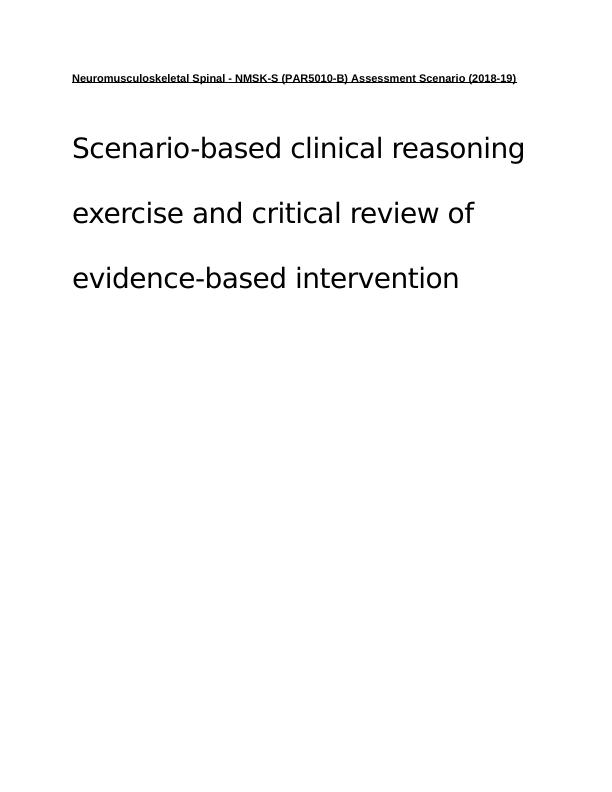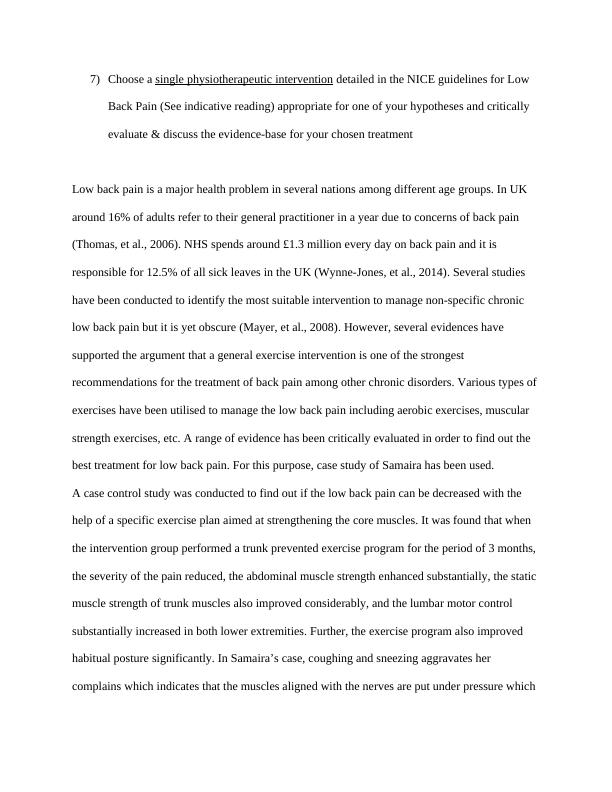Evidence-Based Intervention for Low Back Pain: A Critical Review
Added on 2023-04-21
7 Pages1991 Words392 Views
Neuromusculoskeletal Spinal - NMSK-S (PAR5010-B) Assessment Scenario (2018-19)
Scenario-based clinical reasoning
exercise and critical review of
evidence-based intervention
Scenario-based clinical reasoning
exercise and critical review of
evidence-based intervention

7) Choose a single physiotherapeutic intervention detailed in the NICE guidelines for Low
Back Pain (See indicative reading) appropriate for one of your hypotheses and critically
evaluate & discuss the evidence-base for your chosen treatment
Low back pain is a major health problem in several nations among different age groups. In UK
around 16% of adults refer to their general practitioner in a year due to concerns of back pain
(Thomas, et al., 2006). NHS spends around £1.3 million every day on back pain and it is
responsible for 12.5% of all sick leaves in the UK (Wynne-Jones, et al., 2014). Several studies
have been conducted to identify the most suitable intervention to manage non-specific chronic
low back pain but it is yet obscure (Mayer, et al., 2008). However, several evidences have
supported the argument that a general exercise intervention is one of the strongest
recommendations for the treatment of back pain among other chronic disorders. Various types of
exercises have been utilised to manage the low back pain including aerobic exercises, muscular
strength exercises, etc. A range of evidence has been critically evaluated in order to find out the
best treatment for low back pain. For this purpose, case study of Samaira has been used.
A case control study was conducted to find out if the low back pain can be decreased with the
help of a specific exercise plan aimed at strengthening the core muscles. It was found that when
the intervention group performed a trunk prevented exercise program for the period of 3 months,
the severity of the pain reduced, the abdominal muscle strength enhanced substantially, the static
muscle strength of trunk muscles also improved considerably, and the lumbar motor control
substantially increased in both lower extremities. Further, the exercise program also improved
habitual posture significantly. In Samaira’s case, coughing and sneezing aggravates her
complains which indicates that the muscles aligned with the nerves are put under pressure which
Back Pain (See indicative reading) appropriate for one of your hypotheses and critically
evaluate & discuss the evidence-base for your chosen treatment
Low back pain is a major health problem in several nations among different age groups. In UK
around 16% of adults refer to their general practitioner in a year due to concerns of back pain
(Thomas, et al., 2006). NHS spends around £1.3 million every day on back pain and it is
responsible for 12.5% of all sick leaves in the UK (Wynne-Jones, et al., 2014). Several studies
have been conducted to identify the most suitable intervention to manage non-specific chronic
low back pain but it is yet obscure (Mayer, et al., 2008). However, several evidences have
supported the argument that a general exercise intervention is one of the strongest
recommendations for the treatment of back pain among other chronic disorders. Various types of
exercises have been utilised to manage the low back pain including aerobic exercises, muscular
strength exercises, etc. A range of evidence has been critically evaluated in order to find out the
best treatment for low back pain. For this purpose, case study of Samaira has been used.
A case control study was conducted to find out if the low back pain can be decreased with the
help of a specific exercise plan aimed at strengthening the core muscles. It was found that when
the intervention group performed a trunk prevented exercise program for the period of 3 months,
the severity of the pain reduced, the abdominal muscle strength enhanced substantially, the static
muscle strength of trunk muscles also improved considerably, and the lumbar motor control
substantially increased in both lower extremities. Further, the exercise program also improved
habitual posture significantly. In Samaira’s case, coughing and sneezing aggravates her
complains which indicates that the muscles aligned with the nerves are put under pressure which

causes pain. So, with a special exercise program, the condition of trunk muscles and the motor
control of lumbar regions can be improved and the low back pain can be deceased. However, this
study was specifically conducted on the population of the ballet dancers which may have an
effect on the generalizability of the results. Further, the sample size was also small which also
compromise the application of the outcomes for the general population. Also, the participants
were between the age of 13- 15. Since, the measurements were objective, results could be
considered reliable (Bobály, et al., 2016).
A systematic review was conducted to assess the impact of exercise and physical activity on
Non-Specific Chronic Low Back Pain. The review included the population with Non-Specific
Chronic Low Back Pain aged 18 years or older. Aerobic exercise, muscular strength or
stabilization exercises and/or flexibility training intervention programmes were taken as the
interventions for including in the review. The effect of these interventions was measured on the
population. The review found that different exercise intervention programmes are useful for
Non-Specific Chronic Low Back Pain however, theses may not be beneficial for acute low back
pain. Samaira has shown insidious onset of her low back pain four weeks ago and she even has
history of similar symptoms in past post-delivery. So, her case is of chronic nature and exercise
interventions of muscular strength, flexibility or aerobic fitness will be beneficial in her case.
However, the review only included 14 studies which compromises the generalizability of the
results. Further, the review also considered non-specific low back pain as a homogenous
condition which signifies that all the cases are identical. So, it can be argued that a particular
type of exercise intervention based on a specific area for multiple participants might be
unsuitable. It can be thought that the participants included in studies may have responded in
different ways to the exercise interventions (Gordon & Bloxham, 2016).
control of lumbar regions can be improved and the low back pain can be deceased. However, this
study was specifically conducted on the population of the ballet dancers which may have an
effect on the generalizability of the results. Further, the sample size was also small which also
compromise the application of the outcomes for the general population. Also, the participants
were between the age of 13- 15. Since, the measurements were objective, results could be
considered reliable (Bobály, et al., 2016).
A systematic review was conducted to assess the impact of exercise and physical activity on
Non-Specific Chronic Low Back Pain. The review included the population with Non-Specific
Chronic Low Back Pain aged 18 years or older. Aerobic exercise, muscular strength or
stabilization exercises and/or flexibility training intervention programmes were taken as the
interventions for including in the review. The effect of these interventions was measured on the
population. The review found that different exercise intervention programmes are useful for
Non-Specific Chronic Low Back Pain however, theses may not be beneficial for acute low back
pain. Samaira has shown insidious onset of her low back pain four weeks ago and she even has
history of similar symptoms in past post-delivery. So, her case is of chronic nature and exercise
interventions of muscular strength, flexibility or aerobic fitness will be beneficial in her case.
However, the review only included 14 studies which compromises the generalizability of the
results. Further, the review also considered non-specific low back pain as a homogenous
condition which signifies that all the cases are identical. So, it can be argued that a particular
type of exercise intervention based on a specific area for multiple participants might be
unsuitable. It can be thought that the participants included in studies may have responded in
different ways to the exercise interventions (Gordon & Bloxham, 2016).

End of preview
Want to access all the pages? Upload your documents or become a member.
Related Documents
Appraisal of Low Back Pain Prevention Exercise Programlg...
|7
|1857
|303
Chronic Back Pain: Evidence Synthesis and Intervention Strategieslg...
|1
|1296
|64
Effects of Exercise on Chronic Back Painlg...
|6
|2421
|30
Management of Chronic Lower Back Painlg...
|13
|1242
|17
Healthy Ageing - Benefits of Physical Activitylg...
|7
|2121
|21
Health Aging | Essay | Newlg...
|8
|2185
|19
